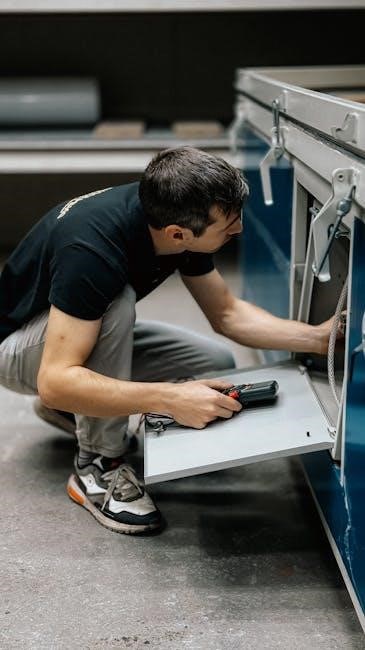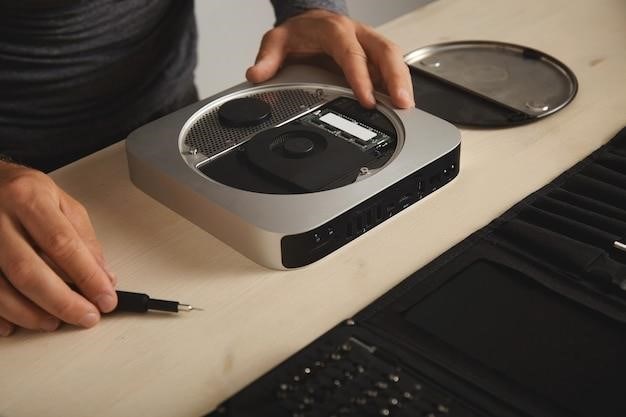The Blackstone manual is your ultimate guide to understanding and mastering your griddle, ensuring safe operation and optimal cooking performance․
From assembly to seasoning, it provides detailed instructions to help you get the most out of your Blackstone griddle experience․

Overview of the Blackstone Griddle
The Blackstone Griddle is a versatile and durable outdoor cooking appliance designed for high-performance grilling, searing, and frying․ Made from heavy-duty steel, it features a spacious cooking surface that allows for efficient food preparation․ Its design includes a flat, even griddle top that distributes heat uniformly, ensuring consistent cooking results․ The griddle is ideal for cooking a wide variety of dishes, from pancakes and eggs to steaks, vegetables, and burgers․ It is available in different sizes, catering to both small family gatherings and large outdoor events․ The Blackstone Griddle is known for its portability, making it easy to transport and set up in various locations․ With its robust construction and user-friendly features, it has become a favorite among outdoor cooking enthusiasts․ Whether you’re a novice or an experienced cook, the Blackstone Griddle offers endless possibilities for creating delicious meals․

Importance of Reading the Manual
Reading the Blackstone Manual is essential for maximizing the performance and longevity of your griddle․ It provides critical information about safety guidelines, proper assembly, and maintenance tips to ensure optimal use․ The manual outlines key features and functions, helping users understand how to operate the griddle effectively․ By following the instructions, you can avoid common mistakes that might damage the appliance or lead to unsafe conditions․ Additionally, the manual includes troubleshooting tips to address potential issues, saving time and frustration․ Understanding the manufacturer’s recommendations ensures compliance with warranty terms and enhances your overall cooking experience․ Whether you’re a first-time user or a seasoned cook, the manual serves as a valuable resource to get the most out of your Blackstone Griddle․ It’s a crucial step in ensuring safety, efficiency, and satisfaction while cooking․

Installation and Setup
Installation and setup of your Blackstone Griddle ensure proper function and safety․ Follow the manual for unboxing, assembly, and initial preparation to get started seamlessly․
Unboxing and Assembly
Unboxing your Blackstone Griddle is an exciting first step․ Carefully inspect the contents, including the griddle, stand, and accessories․ Assembly typically involves attaching the legs, securing the griddle to the stand, and ensuring all parts are tightly fastened․ Follow the manual’s instructions to avoid misalignment or loose connections․ Use the provided hardware and tools to ensure a stable setup․ If you’re new to assembly, take your time and refer to the diagrams for clarity․ Double-check torque specifications to prevent over-tightening, which could damage the unit․ Once assembled, ensure the griddle is level for even heat distribution․ Finally, verify all components are accounted for and properly fitted before moving on to the initial setup․ Proper assembly lays the foundation for safe and effective use of your Blackstone Griddle․
Initial Setup and Preparation
Once assembled, your Blackstone Griddle requires proper preparation before its first use․ Start by inspecting the griddle surface for any protective packaging or residue․ Wash the griddle with mild soap and warm water to remove any manufacturing coatings․ Rinse thoroughly and dry with a clean towel․ Next, apply a thin, even layer of cooking oil to the entire surface, including the edges and underside, to prepare for seasoning․ Allow the oil to dry completely before proceeding․ This step ensures the griddle is ready for the seasoning process, which is essential for non-stick performance․ Always refer to the manual for specific oil recommendations and temperature guidelines․ Proper preparation ensures your griddle is ready for its first use and provides a foundation for long-term durability and performance․

Usage and Cooking Techniques
Mastering your Blackstone Griddle involves understanding heat control, cooking zones, and oil management․ Explore various techniques like searing, frying, and sautéing to achieve perfect results․
Seasoning the Griddle
Seasoning your Blackstone Griddle is essential for creating a non-stick surface and protecting it from rust․ Start by cleaning the griddle with soap and water, then rinse thoroughly․ Apply a thin, even layer of food-safe oil, such as flaxseed or vegetable oil, using a paper towel․ Place the griddle on a burner or in the oven at 350°F (175°C) for an hour to allow the oil to polymerize․ Repeat this process 2-3 times for maximum durability․ Avoid using abrasive cleaners or scouring pads, as they can strip the seasoning․ For maintenance, wipe the griddle clean after use and apply a small amount of oil to the surface․ Proper seasoning ensures optimal performance and longevity of your Blackstone Griddle․
Cooking Tips and Best Practices
Mastering your Blackstone Griddle requires attention to detail and proper techniques․ Always preheat the griddle for 10-15 minutes before cooking to ensure even heat distribution․ Use oil with a high smoke point, like avocado oil, to prevent burning․ Avoid overcrowding the griddle, as this can lower the temperature and affect cooking quality․ Utilize the “zones” on the griddle by creating hotter and cooler areas for searing and finishing dishes․ Clean the griddle between batches to remove residue and prevent flavor transfer․ For delicate foods like eggs or pancakes, use a small amount of oil or butter to prevent sticking․ Don’t press down on burgers or pancakes, as this can push out juices and flatten the food․ Store the griddle properly after cleaning to maintain its seasoning and prevent rust․
Recipes and Meal Ideas
Your Blackstone Griddle is a versatile cooking surface perfect for a wide variety of delicious meals․ Start your day with a hearty breakfast skillet, loaded with scrambled eggs, crispy bacon, and sautéed vegetables․ For lunch, try searing juicy burgers or paninis, paired with caramelized onions and melted cheese․ Dinner options include garlic butter shrimp, steak fajitas, or roasted vegetable stir-fries․ Don’t forget sides like crispy hash browns or grilled asparagus․ Experiment with international flavors, such as Korean BBQ or Mexican quesadillas, to keep your meals exciting․ For dessert, whip up golden-brown pancakes or grilled pineapple with caramel sauce․ The griddle’s even heat allows for perfect cooking results every time․ Get creative and explore endless possibilities to make every meal a success!

Maintenance and Cleaning
Regular cleaning and proper maintenance are essential to preserve your Blackstone Griddle’s performance and longevity․ Always clean the surface after use and season it periodically for durability․
Regular Cleaning and Care
Regular cleaning is essential to maintain your Blackstone Griddle’s performance and longevity․ After each use, allow the griddle to cool slightly before cleaning․ Use a sturdy scraper or spatula to remove food residue, then wipe the surface with paper towels․ Avoid using harsh chemicals, as they can damage the seasoning․ Instead, dampen a paper towel with water and gently scrub the surface․ For tougher residue, mix equal parts water and white vinegar on the griddle and let it sit for 10 minutes before wiping clean․ Always dry the griddle thoroughly after cleaning to prevent rust․ For daily care, ensure the griddle is free of debris and lightly oiled to maintain its seasoning․ Regular maintenance will keep your Blackstone Griddle in optimal condition for years of delicious cooking․
Deep Cleaning and Restoration
Deep cleaning and restoration are necessary to remove stubborn grime and restore your Blackstone Griddle’s surface․ Start by heating the griddle to a high temperature for 10-15 minutes to loosen residue․ Turn off the heat and mix equal parts water and white vinegar or a small amount of baking soda with water to create a paste․ Apply the solution to the griddle and let it sit for 30 minutes․ Use a stiff brush to scrub the surface thoroughly, then rinse with clean water․ For severe buildup, repeat the process as needed․ After deep cleaning, dry the griddle completely and apply a thin layer of oil to restore the seasoning․ Avoid using abrasive cleaners or scouring pads, as they can damage the surface․ Regular deep cleaning ensures your griddle remains in excellent condition and continues to perform optimally․

Troubleshooting Common Issues
Troubleshooting common issues with your Blackstone Griddle involves identifying symptoms, checking connections, and ensuring proper setup․ Always consult the manual for specific guidance and solutions․
Identifying and Resolving Problems
Identifying and resolving issues with your Blackstone Griddle starts with understanding common problems like uneven heating, rust, or food sticking․ Inspect the griddle surface for damage or wear․ For uneven heating, ensure the burner is clean and properly aligned․ If rust appears, sand it off and reseason immediately․ To prevent food from sticking, always preheat the griddle and oil it before cooking․ If issues persist, refer to the manual for detailed troubleshooting steps․ Regular maintenance, such as cleaning and seasoning, can prevent many problems․ Always store the griddle in a dry place to avoid rust․ If you notice gas leaks or ignition failures, disconnect the griddle and contact customer support․ Proper care and timely fixes will extend the griddle’s lifespan and ensure optimal performance․
Common Mistakes to Avoid
When using your Blackstone Griddle, avoid common mistakes that can damage the surface or affect performance․ Never skip seasoning, as it protects the griddle from rust and ensures non-stick cooking․ Avoid using metal utensils or abrasive cleaners, as they can scratch the surface․ Don’t cook on the griddle without preheating it first, as this can lead to uneven cooking and food sticking․ Refrain from using high-pressure hoses or harsh chemicals for cleaning, as they can strip away the seasoning․ Never store the griddle in a damp environment, as moisture can cause rust․ Avoid overcrowding the griddle, as this can lower temperatures and reduce cooking efficiency․ By avoiding these mistakes, you can maintain your Blackstone Griddle’s quality and enjoy consistent cooking results for years to come․

Safety Guidelines
Always handle the Blackstone Griddle with care, as it can get extremely hot during operation․ Use heat-resistant gloves and tongs to prevent burns․ Store it in a dry, well-ventilated area to avoid rust and ensure safety․ Never leave the griddle unattended while in use, especially when children or pets are nearby․ Keep electrical components away from water to prevent accidents․ By following these safety guidelines, you can ensure a safe and enjoyable cooking experience․
Proper Handling and Storage
Proper handling and storage of your Blackstone Griddle are essential for maintaining its performance and ensuring safety․ Always use heat-resistant gloves or tongs when moving or adjusting the griddle, as it can become extremely hot during cooking․ After use, allow the griddle to cool down completely before cleaning or storing it․ Store the griddle in a dry, well-ventilated area to prevent rust and moisture buildup․ If storing outdoors, use a high-quality cover to protect it from the elements․ Regularly inspect the griddle for damage or wear and address any issues promptly․ Proper handling and storage will extend the lifespan of your Blackstone Griddle and ensure safe, reliable operation for years to come;
- Always let the griddle cool before handling or storing․
- Store in a dry, well-ventilated area to prevent rust․
- Use a cover to protect from dust and moisture․
- Keep electrical components away from water․

Accessories and Upgrades
Explore a variety of accessories and upgrades to enhance your Blackstone Griddle experience, including griddle kits, utensils, and interchangeable components for improved functionality and versatility․
- Accessorize with griddle-specific tools for optimal performance․
- Upgrade components to customize your griddle setup․
- Enhance cooking efficiency with tailored add-ons․
Recommended Accessories
To enhance your Blackstone Griddle experience, consider these essential accessories: a griddle-specific spatula for effortless food handling, a grill brush for even oil distribution, and a cleaning kit to maintain the seasoning without damage․ Additionally, a carrying case or stand can provide convenience and protection, while a drip tray or mat helps contain messes․ For inspiration, griddle-specific cookbooks offer a variety of recipes to explore․ Finally, a durable griddle cover protects your investment when not in use, and specialized oils ensure optimal seasoning․ These accessories collectively elevate both functionality and enjoyment of your griddle․
Mastery of your Blackstone griddle unlocks endless culinary possibilities․ With practice, you’ll achieve perfect cooking results․ Enjoy experimenting and savor the joy of outdoor cooking!

Final Thoughts on the Blackstone Manual
The Blackstone manual is an essential guide for maximizing your griddle’s potential․ It provides clear, step-by-step instructions for setup, maintenance, and troubleshooting, ensuring a seamless cooking experience․ Whether you’re a novice or an experienced cook, the manual offers valuable insights to enhance your skills․ By following its guidelines, you can prevent common mistakes, extend the griddle’s lifespan, and cook with confidence․ The manual also emphasizes safety, proper handling, and care, making it a comprehensive resource for Blackstone griddle owners․ With its detailed information and practical advice, the Blackstone manual is a must-have for anyone looking to make the most of their outdoor cooking adventures․ It’s a testament to the brand’s commitment to quality and user satisfaction, ensuring every meal is a success․
Additional Resources for Further Learning
To further enhance your Blackstone griddle experience, explore these additional resources: Blackstone’s official website offers detailed tutorials, FAQs, and troubleshooting guides․ YouTube channels like Blackstone Griddle and Outdoor Cooking Channel provide step-by-step videos for recipes and maintenance․ Social media groups, such as Blackstone Griddle Owners on Facebook, connect you with a community of users sharing tips and ideas․ For hands-on learning, Blackstone occasionally hosts workshops and webinars․ Additionally, online forums like




































